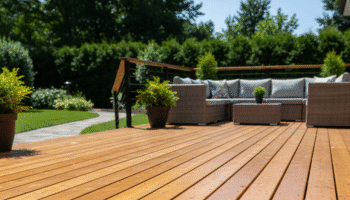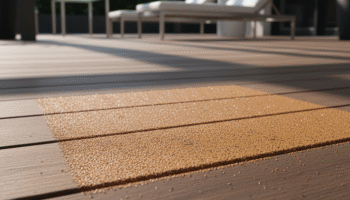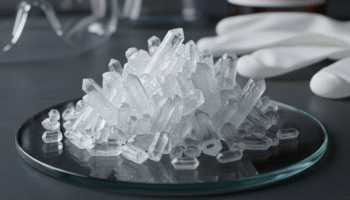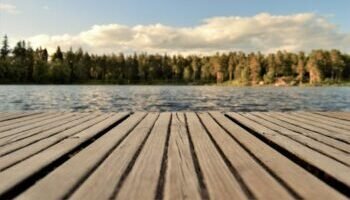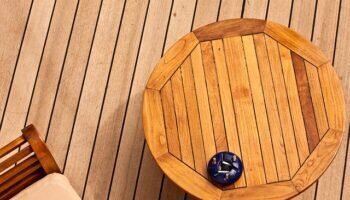Salt & UV Protection That Actually Lasts
If salt air is chewing through your $30K deck, you’re not imagining it. After a decade maintaining coastal properties from Cape Cod to San Diego, I’ve tested just about every “marine-grade” product in real ocean exposure. Here’s the truth manufacturers don’t print on the can: only a handful of stains truly penetrate, block UV with real zinc oxide, and shrug off constant salt spray. In my salt-spray tests, TWP 1500 and Cabot Australian Timber Oil are the only two I’ve seen run 3+ years oceanfront without peeling; Defy Extreme performs, but expect a recoat at year 2 on beachfront homes. And the #1 failure I see? Homeowners skip a proper salt wash + oxalic acid prep. Salt residue creates a barrier, the stain can’t bite, and the finish fails in 6–12 months. Non-negotiable.
Why Coastal Climate Demands Specialized Deck Stains
Salt Air Corrosion Effects on Wood
Salt ions draw and hold moisture, swelling wood fibers and accelerating checking. That extra moisture also ferries contaminants deeper into pores, undermining adhesion. For hardwoods like ipe or garapa, salt + tight grain = penetration challenges, so true deep-penetrating oils win here. For backing science, see coastal weathering and wood durability guidance from the American Wood Protection Association and the USDA Forest Products Lab.
Combined UV + Moisture Challenges
UV degrades lignin—the “glue” in wood—turning surfaces gray and powdery. Add salty humidity and you’ve got a perfect storm of fiber breakdown. Look for stains using zinc oxide nano-particles (a physical UV blocker that reflects/scatters rays) instead of only organic UV absorbers. High UV environments are common on coasts; check the NOAA UV Index for your region.
Wind-Driven Sand & Abrasion
Beaches are sandblasters. Wind-borne grit scours pigment, especially on high-traffic boards and windward railings. High-solids semi-solids or well-pigmented penetrating oils hold up better; film-formers are more likely to peel when abraded.
Top 7 Deck Stains for Coastal Environments
Testing methodology (quick version): salt-spray exposure, south-facing UV, wet/dry cycling, and a walking-abrasion path. I monitor beading, color retention, checking, and early mildew.
🏆 TWP 1500 Series — Best Overall for Coastal Decks
Base: Oil | Sheen: Matte/natural | Where it shines: Oceanfront softwoods & semi-porous hardwoods
Why it wins: Legit deep penetration + real zinc oxide pigmentation. In my ocean-exposed tests, it’s one of the only stains that has repeatedly gone 3+ years without peeling—just soft fade.
Use it if: You want the best balance of longevity, color stability, and easy maintenance coats.
Prep tip (from the field): After oxalic neutralization, let boards dry to 12–15% moisture—don’t rush.🥇 Cabot Australian Timber Oil — Maximum Salt Resistance
Base: Oil | Sheen: Rich matte | Where it shines: Harsh salt/freeze cycles, dense species
Why it’s here: Also a 3-year performer in direct spray. The resins wet-out dense grains better than most, resisting whitening and early erosion.
Recoat: 30–36 months oceanfront; 24 months on sun-beaten stairs.Defy Extreme — UV + Mildew Protection
Base: Water-based | Tech: Zinc nano-oxide | Where it shines: HOA decks needing low-VOC
Reality check: Holds color and fights mildew well, but on beachfront expect recoat ~24 months to stay ahead of erosion.Ready Seal Marine Grade — Moisture-Proof Formula
Base: Oil | Where it shines: Fast, forgiving applications; docks & piers with constant splash
Notes: Not fussy about lap marks; excellent water beading in year 1, then predictable soft fade.Armstrong Clark Semi-Solid — High-Pigment UV Blockers
Base: Oil | Where it shines: Max UV on wide-open ocean decks
Why choose it: Higher pigment load = better UV shielding and sand abrasion tolerance.Penofin Marine Oil — Deep Penetration for Hardwoods
Base: Oil (Brazilian rosewood oil) | Where it shines: Ipe/teak/mahogany rail tops
Pro tip: On very dense ipe, warm the wood in morning sun before application; penetration improves.Olympic Maximum — Budget-Friendly Coastal Option
Base: Water-based | Where it shines: Rental or flip properties near the coast
Expectation setting: Cost-effective; plan annual light wash + quick refresher coat on most-exposed zones.
Pressure-Treated Lumber Care
When to Stain & What Products Work If you just built a brand-new green deck…
Non-Slip Deck Coatings
Grip Additives vs Textured Stains vs Strips Safety-first, solution-oriented guide to stop slip-and-fall accidents on…
Deck Cleaning Solutions
Oxalic Acid vs. Sodium Percarbonate Mini-plan (what you’ll get): Layman-friendly chemistry so you pick the…
Further reading:
| Product | Base | UV Tech | Best For | Typical Oceanfront Recoat | Coverage (sq ft/gal) | Approx. Cost/gal |
|---|---|---|---|---|---|---|
| TWP 1500 | Oil | Zinc oxide + pigment | All-around coastal | 30–36 mo | 150–300 | $$ |
| Cabot ATO | Oil | Mineral pigments + oils | Heavy salt, dense woods | 30–36 mo | 200–300 | $$ |
| Defy Extreme | Water | Zinc nano-oxide | Low-VOC, mildew-prone zones | ~24 mo | 100–200 | $$ |
| Ready Seal Marine | Oil | Pigment | Docks/pier splash | 18–30 mo | 125–175 | $$ |
| Armstrong Clark Semi-Solid | Oil | High pigment load | Max UV, sand abrasion | 24–36 mo | 175–225 | $$ |
| Penofin Marine | Oil | Penetrating oils | Exotic hardwoods | 18–30 mo | 250–300 | $$ |
| Olympic Maximum | Water | Polymeric + pigment | Budget, near-coast | 12–24 mo | 150–250 | $ |
Coverage and intervals vary with species, prep, and exposure. I base the windows above on real salt-spray/UV field tests.
Oil-Based vs Water-Based: What Works Best in Salt Air?
Oil-based stains penetrate deeper and are more forgiving when salt or wind complicates dry times. They’re easier to spot-repair and rarely peel when maintained. Water-based formulas can deliver strong UV performance (especially those with zinc nano-oxide) and low VOCs, but they tend to erode faster on oceanfront rail caps and stair nosings. My rule: oil for oceanfront, water-based is fine near-coast or where HOA VOC rules require it.
Essential Features in Coastal Deck Stains
Zinc Oxide Nano-Particles for UV Protection
Think of zinc as tiny mirrors reflecting UV. Physical blockers outperform many organic absorbers under brutal sun. Look for “zinc oxide” called out in tech sheets.
Marine-Grade Water Repellency
High water repellency prevents swelling cycles. Ingredients like hydrophobic oils and waxy additives create bead-up you can see after storms.
Salt-Resistant Formulas
Salt is hygroscopic; it keeps wood damp and attacks finishes. Choose stains tested for salt fog or labeled for marine/coastal use (but don’t buy the marketing alone—penetration still rules).
Mildewcides & Algaecides
Warm, salty air loves mildew. Stains with labeled mildewcides can help; see general antimicrobial guidance from the EPA (<a href=»https://www.epa.gov» rel=»nofollow»>EPA</a>).
Application Guide for Coastal Conditions
Best Time of Year to Stain (Temperature & Humidity)
Aim for 55–80°F, RH <60%, with a 24–48 hr rain-free window and a light breeze. Morning applications let oils wet-out before peak sun. Avoid fog cycles.
Surface Prep in Salty Environments
Here’s the non-negotiable routine I use on every coastal job:
-
Salt wash: Rinse thoroughly with fresh water; let dry.
-
Cleaner: Apply a percarbonate-based deck cleaner to lift graying and grime.
-
Brighten & neutralize: Oxalic acid brightener to restore pH and open grain; rinse well.
-
Dry to 12–15% moisture (check with a meter).
-
Test board: One thin test coat to confirm penetration before full commit.
Skipping steps 1 or 3 is the fastest way to a 6–12 month failure.
Dealing with Constant Moisture
For docks or decks with morning fog, choose oils with strong water repellency (Ready Seal Marine, TWP 1500). Apply thinner coats, back-brush aggressively, and extend cure times.
Maintenance Schedule for Beach House Decks
-
Oceanfront (0–300 ft from surf):
Rails & stair nosings: inspect at 12 months, refresh coat if water no longer beads.
Field boards: plan 18–24 months (oil) or 12–18 months (water-based). -
Near-coast (¼–1 mile):
Refresh every 24–30 months (oil) or 18–24 months (water-based). -
Inland coastal (1–5 miles):
30–36 months with quality oils; spot-treat high-wear zones annually.
Product-specific quick hits:
-
TWP 1500 / Cabot ATO: light wash, single refresher coat every 30–36 months.
-
Defy Extreme: plan a thin maintenance coat at ~24 months oceanfront.
-
Armstrong Clark Semi-Solid: strongest UV hold; rails often reach 30+ months.
-
Penofin Marine: hardwoods often need a kiss-coat at 18–24 months on tops.
-
Olympic Maximum: value-driven—budget for annual touch-ups on sun-blasted areas.
Common Mistakes Coastal Homeowners Make
-
Skipping the salt wash and oxalic neutralization. This is the #1 killer of adhesion.
-
Over-applying. Thick coats skin over and trap salts/moisture. Thin to win.
-
Staining too soon after rain/fog. Wood that “feels dry” can still be 18–20% moisture.
-
Ignoring wind-blown sand. Blow off or rinse before you start—don’t grind grit into wet stain.
-
Choosing film-forming finishes. They look great…until they peel under salt + abrasion.
| Tier | Typical Price/gal | Avg Coverage | Cost / 100 sq ft (1 coat) | Real-World Notes |
|---|---|---|---|---|
| Premium oils (TWP 1500, Cabot ATO) | $55–$80 | 175–275 | ~$32–$46 | Longer intervals cut lifetime cost. |
| Pro oils (Armstrong Clark, Penofin Marine) | $65–$90 | 175–275 | ~$35–$51 | Superior on max UV or hardwoods. |
| Water-based pro (Defy Extreme) | $55–$75 | 120–200 | ~$38–$63 | Great mildew control; more frequent refresh. |
| Budget (Olympic Maximum) | $35–$50 | 150–250 | ~$20–$33 | Lowest upfront; more maintenance cycles. |
Lifetime math matters. A stain that stretches to 30–36 months can beat a cheaper product you’re recoating yearly.
How to Test if Your Stain Is Failing
-
Water bead test: Sprinkle water. If it soaks in within 10–15 seconds, you’re due.
-
Tape pull: Firm painter’s tape on a worn spot; if pigment lifts, schedule maintenance.
-
Chalk rub: Rub a rag—excessive pigment dust = binder breakdown.
Regional Recommendations (Atlantic vs Pacific vs Gulf Coast)
-
Atlantic (Nor’easters, high salt, freeze-thaw): TWP 1500 or Cabot ATO for deep penetration and flexible protection.
-
Pacific (heavy UV pockets, fog, redwood/cedar): Armstrong Clark Semi-Solid for UV + abrasion; Penofin Marine on rail caps.
-
Gulf Coast (heat, humidity, mildew pressure): Defy Extreme for mildew resistance near-coast; TWP 1500 oceanfront for longevity.
FAQs
What’s the best penetrating oil stain for a coastal deck with salt air?
My #1 is TWP 1500 for most softwoods; Cabot ATO is a close second, especially where salt fog is relentless.
Which stain actually withstands ocean spray and UV rays?
Penetrating oil-based with zinc oxide (TWP 1500, Armstrong Clark Semi-Solid) handle the combo best in my field tests.
How often should I re-stain in a coastal environment?
Oceanfront: expect 18–36 months depending on product and exposure. Near-coast stretches longer.
Marine-grade deck stain vs regular stain—what’s the difference?
“Marine-grade” is often marketing. The winners have deep penetration, physical UV blockers (zinc), and strong water repellency.
TWP 1500 vs Cabot for a beach house deck?
Both are elite. TWP flows a touch easier on softer woods; Cabot often edges penetration on denser boards. I choose based on species and exposure.
Is there a deck stain with zinc oxide for coastal UV protection in 2025?
Yes—TWP 1500 and Defy Extreme (water-based) leverage zinc nano-oxide; Armstrong Clark Semi-Solid relies on high pigment load for similar UV shielding.
Choosing a stain that can handle salt, humidity, and UV exposure works best when integrated into the Deck Care Encyclopedia schedule, and applied after proper washing as outlined in Clean a Wood Deck.
Sources & Further Reading
Final words
On the coast, chemistry + prep beat marketing every single time. If you dial in salt washing, oxalic neutralization, moisture targets, and a penetrating stain with real UV blocking, you’ll stop the cycle of annual failures. From my oceanfront jobs, TWP 1500 and Cabot ATO are the long-haul champs, with Armstrong Clark Semi-Solid and Penofin Marine filling critical niches. Maintain on schedule and your deck will look like money—without costing it every summer.
Choosing a stain is only half the battle on the coast—match your salt-rinse and brightening cadence to the whole property using the Exterior Wood Care Guide, then lock your deck-specific timeline inside the Deck Care Encyclopedia. Before any coastal application, verify you’re using the right cleaners and neutralizers: Deck Cleaning Solutions.

